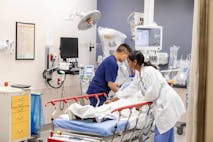
Details shrouded in secrecy as third woman in a month is injured at Rhode Island Planned Parenthood
Bridget Sielicki
·
Abortion Pill·By Michael J. New
Studies purporting to show safety of telemedicine abortions are unpersuasive
(Daily Signal) Pro-life advocates suffered a policy setback last week when the Food and Drug Administration lifted existing restrictions on telemedicine abortions for the duration of the COVID-19 pandemic.
This past year, groups supporting legal abortion litigated against Trump administration FDA rules, which required that chemical abortions occur under medical supervision.
Supporters of legal abortion obtained a favorable ruling from a U.S. district court judge in July. However, in January, the U.S. Supreme Court ruled that the Trump administration’s protective rules were constitutional and could remain in place.
However, the Biden administration’s new FDA rules will make it possible for women to obtain chemical abortion drugs by mail and undergo chemical abortions without any in-person medical supervision.
As such, it should come as no surprise that in recent days, supporters of legal abortion and their allies in the mainstream media are working overtime to try to make the case that telehealth abortions do not pose health risks.
However, the evidence they provide is weak—and in some cases demonstrates that telehealth abortions actually do pose serious health risks.
The following is a summary of studies that have been cited in various mainstream media outlets.
On April 12, USA Today published an opinion column by Rachel Rebouche and Ushma Upadhyay that advocated for both the legalization and expansion of telemedicine abortions. They cited research from an ongoing study Upadhyay is leading as evidence that telehealth abortions are “safe and effective.” However, since the study has not yet been published, it’s impossible to evaluate the quality of the research or even the definition of “safe and effective.”
BJOG: An International Journal of Obstetrics and Gynaecology published a study in February that purportedly shows that telemedicine abortions do not pose health risks. However, the study contains a significant methodological weakness. It compares outcomes from two groups of women who obtained chemical abortions in England. The first group of women all obtained chemical abortions under medical supervision. The second group consisted of some women who obtained telehealth abortions and others who obtained chemical abortions under medical supervision. In short, the outcomes of women who obtained telehealth abortions are not considered separately from women who obtained abortions under medical supervision. As such, this study provides very little information about the safety of telehealth abortions.
The New York Times and other media outlets have cited a study that was published in the journal Contraception in March as evidence that telehealth abortions are safe. The authors obtained data from the TelAbortion Project. The TelAbortion Project performed some telemedicine abortions under an Investigational New Drug application between 2016 and 2018. It performed a larger number of telehealth abortions in 2020 after a summer court order temporarily struck down FDA rules limiting telehealth abortions. The study found that within a month of the abortion, 6% of those who had telemed abortions made visits to emergency rooms or urgent care centers for reasons related to the abortion.
Other research shows that the emergency room visit rate for abortion-related reasons is about 2.6%.
Additionally, the actual emergency room visit rate for the Contraception study might actually be higher than reported. That’s because the Contraception study relied on surveys and it obtained abortion outcome information for only 83% of the abortions that took place.
READ: Study suggests abortion pill complications are underreported, and ERs are managing the majority
Article continues below
Dear Reader,
In 2026, Live Action is heading straight where the battle is fiercest: college campuses.
We have a bold initiative to establish 100 Live Action campus chapters within the next year, and your partnership will make it a success!
Your support today will help train and equip young leaders, bring Live Action’s educational content into academic environments, host on-campus events and debates, and empower students to challenge the pro-abortion status quo with truth and compassion.
Invest in pro-life grassroots outreach and cultural formation with your DOUBLED year-end gift!
Good research has shown that even under proper medical supervision, chemical abortions pose significant health risks.
A 2015 Obstetrics and Gynecology study analyzed comprehensive data from California’s Medicaid program. It found that the complication rate for chemical abortions was four times greater than the complication rate for surgical abortions.
Chemical abortions without medical supervision will pose even greater risks. Obtaining a chemical abortion during an ectopic pregnancy could be fatal for the pregnant woman.
Additionally, a woman obtaining a chemical abortion may underestimate the gestational age of her unborn child. That could also pose health risks. At least one company offering telemed abortions acknowledges those specific risks on its website.
Overall, expanding chemical abortions has been a long-term goal for supporters of legal abortion. Recent data from the Centers for Disease Control and Prevention show that chemical abortions constitute about 40% of all abortions performed in the United States.
Furthermore, as surgical abortion facilities continue to close, supporters of legal abortions have sought to make chemical abortions available remotely.
It’s tragic that the Biden administration’s FDA ignored the legitimate health risks involved with chemical abortions. That decision to allow women to obtain chemical abortions without in-person medical supervision will pose serious health risks for countless women and result in the deaths of numerous unborn children.
Editor’s Note: This article was published at the Daily Signal and is reprinted here with permission.
“Like” Live Action News on Facebook for more pro-life news and commentary!
Live Action News is pro-life news and commentary from a pro-life perspective.
Contact editor@liveaction.org for questions, corrections, or if you are seeking permission to reprint any Live Action News content.
Guest Articles: To submit a guest article to Live Action News, email editor@liveaction.org with an attached Word document of 800-1000 words. Please also attach any photos relevant to your submission if applicable. If your submission is accepted for publication, you will be notified within three weeks. Guest articles are not compensated (see our Open License Agreement). Thank you for your interest in Live Action News!

Bridget Sielicki
·
Human Interest
Andrea Trudden
·
Abortion Pill
Carole Novielli
·
Abortion Pill
Carole Novielli
·
Abortion Pill
Carole Novielli
·
Abortion Pill
Bridget Sielicki
·
Guest Column
Michael J. New
·
Guest Column
Michael J. New
·
Guest Column
Michael J. New
·
Guest Column
Michael J. New
·
Guest Column
Michael J. New
·